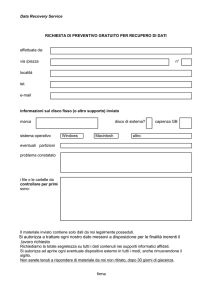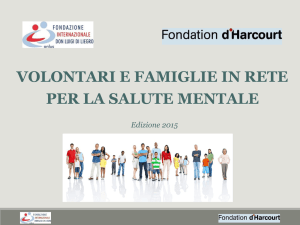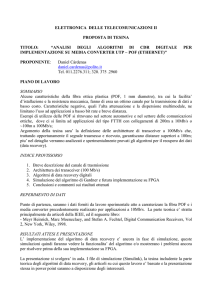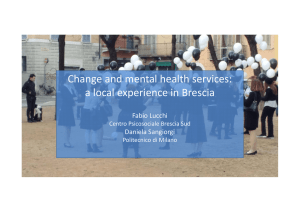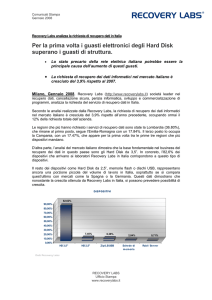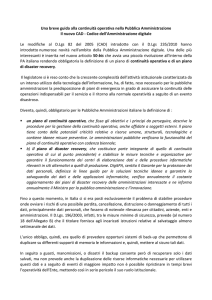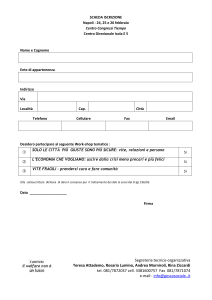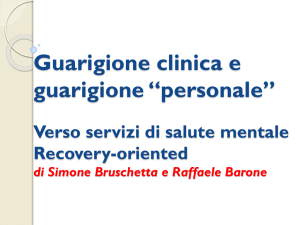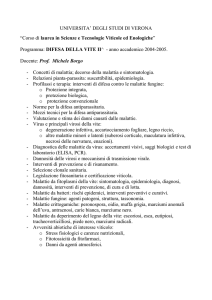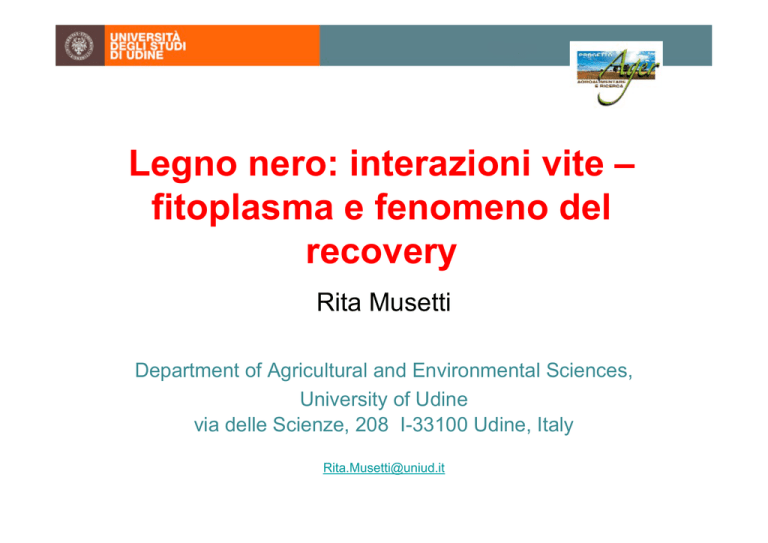
Legno nero: interazioni vite –
fitoplasma e fenomeno del
recovery
Rita Musetti
Department of Agricultural and Environmental Sciences,
University of Udine
via delle Scienze, 208 I-33100 Udine, Italy
[email protected]
Legno nero (Bois noir)
Ø Giallumi della vite :
Sono economicamente incidenti, epidemiche
e non curabili
Ø L’agente eziologico di BN è ‘Candidatus Phytoplasma solani’, appartenente al
gruppo dello Stolbur 16SrXII
Ø Diagnosi difficile, ad oggi possibile solo su foglie e al momento della comparsa dei
sintomi.
Ø Interazioni pianta/patogeno: ad oggi ancora poco note
Ø Fenomeno del ‘recovery’: le piante sintomatiche/infette possono manifestare
remissione spontanea dei sintomi e tornare produttive
Obiettivi
Bois Noir- ‘Candidatus Phytoplasma solani’
q Sviluppare nuovi metodi diagnostici adatti all'analisi in
organi della vite diversi dalla foglia come le radici.
q Implementare le conoscenze sulle interazioni vite/
patogeno
q Far luce sui meccanismi grazie ai quali le viti infette
riescono ad innescare i processi che portano al
‘recovery’.
Strategie di intervento adottate
Approccio integrato che prevede l’utilizzo di metodiche di biologia
molecolare, biochimica, proteomica, fisiologia, microscopia ottica ed
elettronica nonché genomica funzionale, attraverso il sequenziamento e
la caratterizzazione del trascrittoma (RNA-seq) di tessuto floematico
isolato mediante Laser Microdissection, e bioinformatica
Localizzazione fitoplasma in
Vitis vinifera (cv Chardonnay)
• Diagnosi in foglie
A rapid protocol for detecting
the BN phytoplasma was
optimized using one-step real-time RT-PCR
(Santi et al., 2013)
One-step real-time RT-PCR was carried
out to detect transcripts of the 16S rRNA
gene and DNAK gene of ‘Ca. P. solani’
N° Filare N° Pianta 10 10 10 10 10 8 10 10 10 10 10 10 10 10 11 Stato fitosanitario 2012 63 Asintoma;ca 59 Asintoma;ca 144 D 133 D 119 D 182 H 171 H 166 H 155 H 154 H 147 R 127 R 123 R 65 R 43 R Diagnosi molecolare -­‐ -­‐ + + + -­‐ -­‐ -­‐ -­‐ -­‐ -­‐ -­‐ -­‐ -­‐ 5
-­‐ Diagnosi di Bois Noir in radici di vite
Il metodo è risultato utile per la diagnosi del fitoplasma in due individui malati (10-144 e 10-59) e tre
recovered (11-71, 10-127 e 10-147). Per gli individui sani non è stata rilevata la presenza del patogeno, a
conferma del loro stato fitosanitario.
Il basso numero di positivi ottenuti tra gli individui sintomatici può essere dovuto alle difficoltà di estrazione
dell’RNA da tessuto radicale e dalla bassa concentrazione e sporadica distribuzione del patogeno nella pianta.
Recovery
• Phytoplasmas are associated to economically important plant
diseases
• No curative methods are available
• Recovery: spontaneous remission of disease symptoms
Is possible to use recovery as a strategy for
phytoplasma-disease control?
In which cases and diseases?
• Phytoplasma-infected plants can exhibit
recovery = remission of disease symptoms
(Caudwell, 1961; Schmid, 1965; Osler et al.,
2000; 2003; Carraro et al., 2004)
• Recovery in apple and grapevine: no
symptoms and no phytoplasmas in the
crown; but the roots are still full infected
• Recovery in apricot: no symptoms, but still
infected
• Recovery occurs also in individuals showing
severe symptoms since several years
02/04/15 8 Recovery: what we know
• When recovered plants are exposed to a high
pressure of disease in the field, the probability
of developing symptoms is four times lower if
compared with never infected trees (Osler et
al., 2000)
• In recovered plants, processes of acquired
resistance have been demonstrated (Musetti et
al., 2004; 2005; 2007)
02/04/15 9 Some epidemiological data on recovery
•
•
•
•
Common in AP diseased apples (20% of incidence as mean value)
Common in FD/BN diseased grapes (20% of incidence as mean value)
Less common in ESFY diseased apricots (rare)
Variable in PD diseased pears (mainly depending on rootstocks and
cultivars)
Recovery can be permanent under certain circumstances (it depends
by host genotype, rootstock, environment…)
Recovered plants are not sources of inoculum for disease spread • No phytoplasma detec;on using sierological (IF, apple) and molecular methods (nested-­‐PCR, RT-­‐
PCR, apple and grapevine) • No trasmission by graUing (Carraro et al., 2004; 2009) • No transmission by insect vectors (GaleYo et al., 2009) Recovery: cases of study on grapevines
FD/Prosecco in Valdobbiadene (Treviso, Veneto,
Italy)
BN/Chardonnay in Lucinico (Gorizia, Friuli
Venezia Giulia, Italy)
The example of FD in Valdobbiadene-Prosecco
During the period 1993-1998 about 1.250.000 grapes
recovered = almost 100% of the infected plants (Director of
Consortium ProseccoValdobbiadene).
The recovery seems to be stable
in fact:
from 1999 till 2003 (6 years) the general situation
is stably based on 0 - 0,5% of symptomatic plants.
In practice the FD-problem was solved by:
ü Insecticide treatment against Scaphoideus titanus
ü No grape extirpation
ü Waiting for recovery (stable at Valdobbiadene)
Behaviour of FD during 9 years (1994-2002) of observations on
1145 grapes.
Area: Valdobbiadene-Prosecco, TV.
No rogueing Yes insecticide treatment Yes recovery
Symptomatic grapes %
70
65
60
50
Mean annual rate of recovery = 45% 45
40
30
25
20
9
10
0
0,5
0
0
1 ('94)
2 ('95)
3 ('96)
4 ('97) 5 ('98)
Years
0
6 ('99)
0
7 ('00)
0
8 ('01)
0
9 ('02)
GY: rate of spontaneous recovery (symptom remission) in
grapevines in North-Eastern Italy
Years of
Plant
observation examined
n°
n°
Annual
rate of
recovery
%
Disease
Cultivar
Place
BN
Chardonnay
Friuli - UD
13
13.000
21
Chardonnay
Friuli - PN
16
2580
28
Prosecco
Veneto - TV
Valdobbiadene
9
1047
45
(Mutton et al.,)
BN
(Osler et al.,)
FD
The expected probability for BN-infected Chardonnay grapes to
recover depends also on the severity level of symptoms
Level of disease - severity
% of recovery during the
following year
1 (mild)
37,1
2 (intermediate)
25,8
3 (severe)
19,8
Mutton, Pavan, Frausin et al. 2002
Recovery from BN in grapevine:
Vineyard characteristics:
Located near Gorizia (N.E. Italy) in 2001,
Chardonnay clone ENTAV-INRA 548 on 3
rootstocks; density: 5555 vines/ha
Rootstocks
- 1103 Paulsen (Vitis berlandieri x V. rupestris)
- SO4 (V. berlandieri x V. riparia)
- 420A (V. berlandieri x V. riparia)
First symptomatic plants in 2003: starting from
2006 surveys every year for symptomatic plants
and randomly sampling for real-time PCR (only
Stolbur phytoplasma detected in this area)
Symptomatic plants on the surveyed plants
Year
2006
2007
2008
2009
2010
2011
2012
420A
103/551
90/539
52/538
22/535
28/533
29/531
21/531
SO4
82/566
94/565
70/564
37/564
20/563
19/561
22/559
1103
Paulsen
16/519
28/517
24/515
12/512
12/511
6/509
9/508
201/1623
212/1621
146/1617
71/1611
60/1607
54/1601
52/1598
rootstock
total
Prevalence of the disease
(number of symptomatic
grapevines)
Annual rate of recovery
(% of recovered vines among the previously
symptomatic)
year
2007
2008
2009
2010
2011
2012
1103
37,5
42,9
62,5
46,2
62,3
62,5
S04
24,4
38,7
60,0
48,6
42,4
58,8
420A
24,3
51,0
65,4
36,4
53,1
63,3
rootstock
Is Recovery a resistance?
Physiological and molecular
bases
of Recovery: studies on apple
and grapevine
TEM micrographs from grapevine leaf tissues reveal ultrastructural
modifications in the phloem.
A) Healthy
B) Infected
C) Recovered
Pp
Santi et al., 2013. Frontiers in Plant Science 4: 171-182
C
A
B
In recovered plants : n Changes in the oxida;ve status of the phloem n Downregula;on of H2O2 scavengers n Accumula;on of H2O2 (Muse_ et al., 2007)
defence mechanism ac;va;on (resistance) Musetti et al., 2007
Stolbur disease in grapevine: callose accumulation in
the sieve plates
Recovery from stolbur disease in grapevine involves
changes in sugar transport and metabolism
SUC transporters: high expression
in R grapevine
Sucrose:
involved in
defense
signaling
Priming
molecule for
rapid
activation of
defense
mechanisms
SUS: high expression
in D grapevine
Santi et al., 2013
La diminuzione del trasporto del saccarosio osservato a livello trascrizionale, così
come l’aumento della sintesi del saccarosio mediato da invertasi acida di parete e
saccarosio-sintasi confermano che il fitoplasma dello stolbur induce nelle foglie di
vite il cambiamento da organi ‘source’ in organi ‘sink’, e che le piante ‘recovered’
ripristinano completamente la funzione di sintesi e trasporto dei carboidrati
mostrando, allo stesso tempo, di aver acquisito una maggiore capacità di attivare
i segnali di difesa contro il patogeno.
24
Elettroforesi 2D per l’analisi delle proteine differenzialmente espresse
Identificate 33 proteine differenzialmente espresse in risposta a infezione da BN di cui
9 solo nelle piante R
Degola, Sanità di Toppi, unpublished
Molecole segnale
Contenuto SA
Il contenuto di SA (sia libero che
totale) nelle foglie è
significativamente più elevato
nelle piante infette in presenza di
sintomi
Ederli, Zadra, Badiani & Pasqualini, unpublished
Molecole segnale
Contenuto JA
Ederli, Zadra, Badiani & Pasqualini, unpublished
Il contenuto di JA e MeJA nelle
foglie è significativamente più
elevato nelle piante infette già
prima della comparsa dei sintomi,
ed è elevato anche nelle piante
recovered.
Geni codificanti metaboliti di JA
Il livello di trascrizione dei geni
codificanti per AOC, OPR1 e
JMT, coinvolti nelle ultime fasi
della sintesi di JA e nella sua
trasformazione nella forma
metilata, risultava in generale
significativamente più elevato
nelle piante malate (D) e
“recovered” (R) rispetto alle
piante sane (H) in tutti e tre
prelievi effettuati
Ciaffi, unpublished
High-throughput mRNA
sequencing (RNA-seq)
of LM-isolated phloem
Identification of new genes and new splice variants of known ones;
Identification of rare and cell-specific transcripts;
Comparison of gene and transcript expression level under healthy, infected
and recovered conditions
Isolamento di tessuto
floematico da foglia
Santi et al., 2013
High-throughput mRNA
sequencing (RNA-seq)
of LM-isolated phloem
• 200 geni espressi in modo differenziale
nelle piante R rispetto a quelle H e D
• 50 sono peculiari delle piante R
31
Conclusioni
ü E’ stato messo a punto un metodo innovativo per la diagnosi di Bois Noir
in radici di vite
ü Il fenomeno del ‘recovery’ in vite è associato a modificazioni
ultrastrutturali, biochimiche e molecolari del floema
ü L’infezione da stolbur causa una significativa alterazione del trasporto e
del metabolismo del saccarosio
ü Il dosaggio di molecole segnale rivela l’attivazione di meccanismi di
difesa diversi in piante sintomatiche o ‘recovered’
ü E’ stato messo a punto un metodo per isolare il tessuto floematico da
foglie di vite ed analizzarne il trascrittoma
Ringraziamenti
ProgeYo n° 2010-­‐2106: Giallumi della vite: tecnologie innova;ve per la diagnosi e per lo studio delle interazioni pianta/patogeno


